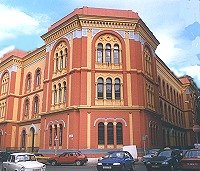| Syrian military helicopter downed in Damascus by rebel forces |
Regime forces reportedly go on killing spree in Daraya, massacre hundreds • Meanwhile, Syrian VP Farouk al-Sharaa resurfaces in Damascus, after three-week disappearance, to meet high-ranking Iranian official.
Elsewhere in Syria, mounting evidence came to light Sunday of a new massacre in the country’s deepening civil war. Activists reported a killing spree by government forces after they seized the suburb of Daraya from rebel control three days ago. Reports of the death toll ranged from more than 300 to as many as 600.
Video footage posted by activists on Monday showed lineups of corpses, many of them men with gunshot wounds to their heads. During mass burials on Sunday, bodies were sprayed with water from hoses — a substitute for the ritual washing prescribed by Islam — in the face of so many dead.
The gruesome images appeared to expose the lengths to which the Assad regime was willing to go to put down the rebellion that first broke out in March last year.
In an ominous commentary, Assad was quoted by his official media as saying his regime would carry on fighting „whatever the price.”
„It is clear that was collective punishment,” Khaled Al-Shami, an activist from Damascus, said of the killings in Daraya. „I am certain that the coming days will reveal more massacres; but by then others will have taken place and people will forget about Daraya.”
The video footage and death toll were impossible to independently verify because of severe restrictions on media coverage of the conflict. However, activists and residents have reported excessive use of force by the regime, with indiscriminate bombing from the air and ground.
Troops backed by tanks stormed the town on Thursday after a siege that lasted several days during which no one was allowed to enter or leave, activists and residents said. The rebels were no match for Assad’s tanks and helicopter gunships.
Most of the killings, according to activists, took place Friday and Saturday. But the extent of the carnage only began to be revealed Sunday.
The British-based activist group Syrian Observatory for Human Rights said 45 more dead bodies were found in the streets of Daraya on Sunday and that they had been killed by „gunfire and summary executions.” Among them, it said, were three women and two children. It said the toll for the past week was at least 320.
Rami Abdul-Rahman, the observatory’s director, said activists on the ground identified 207 of the 320.
The Local Coordination Committees also reported 45 deaths Sunday and said 300 bodies were discovered a day earlier in Daraya, with a total of 633 people killed there since the government launched its assault. It said 1,755 people had been detained in Daraya, suggesting that hundreds more might turn up dead.
Al-Shami, the Damascus activist, and Abdul-Rahman said Daraya was under a de facto curfew Sunday, as Assad’s forces carried out house-to-house searches as well as execution-style killings.
The Internet had been disconnected by authorities, said Al-Shami, who did not use his real name for fear of reprisals.
The fighting in Dayara, according to activists, is being carried out by the Syrian army’s elite 4th Division, which is led by Assad’s brother, Maher. The division is by far the best trained and armed outfit and is primarily tasked with securing the capital.
One theory as to what triggered such a large-scale military operation was that rebel mortar teams have targeted the capital’s military Mazzeh airport, which abuts Daraya. Activists said the regime was intent on protecting the facility as a potential gateway out of the capital for Assad and pillars of his regime if the situation dramatically worsens.
One possible trigger was the reported assassination of the head of Syria’s air force intelligence, Gen. Jamil Hassan, in his Damascus office by one of his aides.
Syrian opposition sources told Al Arabiya on Sunday that Hassan was reportedly killed on Saturday in his office by an aide who worked with the „Ahfad al-Rasul,” or „Grandchildren of the Prophet Brigade.”
Hassan, an Allawite from Homs, is reportedly considered one of Assad’s closest advisers.
Britain’s Middle East minister, Alistair Burt, said on Sunday that if confirmed, the Daraya killings „would be an atrocity on a new scale requiring unequivocal condemnation from the entire international community.”
Also in Damascus on Sunday, Syrian Vice President Farouk al-Sharaa appeared in public for the first time in weeks, ending rumors that he had defected. Reporters saw him get out of his car and walk to his office for a meeting with Alaeddin Boroujerdi, head of Iran’s powerful parliamentary committee on national security and foreign policy.
There have been a series of high-level defections from the Assad regime in the past few months.
Al-Sharaa was last seen at the funeral of four top security officials killed in a blast in Damascus on July 18. Since then, there were rumors that he had defected to Jordan, though al-Sharaa’s office and Jordan repeatedly denied the claims.
On the Turkish-Syrian border, meanwhile, several thousand Syrians gathered at the Bab al-Salameh border crossing, having fled airstrikes in their northern towns and villages. They squatted on the sidewalks of three large hangars once used for cargo inspections of trucks. Some said they had been there a week or more.
Mohammed Abdel-Hay, 41, said his family of seven fled the village of Marea after a regime warplane bombed it last week, destroying a house and killing two people.
„They shelled us and we didn’t leave. They hit us with helicopters and we didn’t leave. Then they brought warplanes that dropped huge bombs that destroyed entire houses and we left,” he said.














